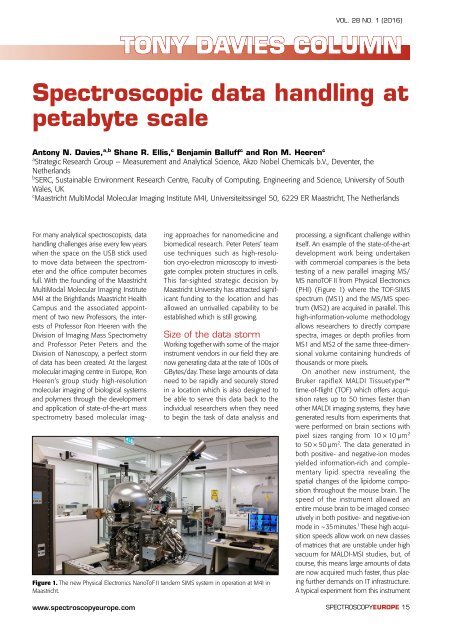Raman spectroscopy of biological pigments Solid mixed matrices in MALDI/TOF-MS
1VpTi1r
1VpTi1r
Create successful ePaper yourself
Turn your PDF publications into a flip-book with our unique Google optimized e-Paper software.
VOL. 28 NO. 1 (2016)<br />
TONY DAVIES COLUMN<br />
Spectroscopic data handl<strong>in</strong>g at<br />
petabyte scale<br />
Antony N. Davies, a,b Shane R. Ellis, c Benjam<strong>in</strong> Balluff c and Ron M. Heeren c<br />
a Strategic Research Group – Measurement and Analytical Science, Akzo Nobel Chemicals b.V., Deventer, the<br />
Netherlands<br />
b SERC, Susta<strong>in</strong>able Environment Research Centre, Faculty <strong>of</strong> Comput<strong>in</strong>g, Eng<strong>in</strong>eer<strong>in</strong>g and Science, University <strong>of</strong> South<br />
Wales, UK<br />
c Maastricht MultiModal Molecular Imag<strong>in</strong>g Institute M4I, Universiteitss<strong>in</strong>gel 50, 6229 ER Maastricht, The Netherlands<br />
www.<strong>spectroscopy</strong>europe.com<br />
For many analytical spectroscopists, data<br />
handl<strong>in</strong>g challenges arise every few years<br />
when the space on the USB stick used<br />
to move data between the spectrometer<br />
and the <strong>of</strong>fice computer becomes<br />
full. With the found<strong>in</strong>g <strong>of</strong> the Maastricht<br />
MultiModal Molecular Imag<strong>in</strong>g Institute<br />
M4I at the Brightlands Maastricht Health<br />
Campus and the associated appo<strong>in</strong>tment<br />
<strong>of</strong> two new Pr<strong>of</strong>essors, the <strong>in</strong>terests<br />
<strong>of</strong> Pr<strong>of</strong>essor Ron Heeren with the<br />
Division <strong>of</strong> Imag<strong>in</strong>g Mass Spectrometry<br />
and Pr<strong>of</strong>essor Peter Peters and the<br />
Division <strong>of</strong> Nanoscopy, a perfect storm<br />
<strong>of</strong> data has been created. At the largest<br />
molecular imag<strong>in</strong>g centre <strong>in</strong> Europe, Ron<br />
Heeren’s group study high-resolution<br />
molecular imag<strong>in</strong>g <strong>of</strong> <strong>biological</strong> systems<br />
and polymers through the development<br />
and application <strong>of</strong> state-<strong>of</strong>-the-art mass<br />
spectrometry based molecular imag<strong>in</strong>g<br />
approaches for nanomedic<strong>in</strong>e and<br />
biomedical research. Peter Peters’ team<br />
use techniques such as high-resolution<br />
cryo-electron microscopy to <strong>in</strong>vestigate<br />
complex prote<strong>in</strong> structures <strong>in</strong> cells.<br />
This far-sighted strategic decision by<br />
Maastricht University has attracted significant<br />
fund<strong>in</strong>g to the location and has<br />
allowed an unrivalled capability to be<br />
established which is still grow<strong>in</strong>g.<br />
Size <strong>of</strong> the data storm<br />
Work<strong>in</strong>g together with some <strong>of</strong> the major<br />
<strong>in</strong>strument vendors <strong>in</strong> our field they are<br />
now generat<strong>in</strong>g data at the rate <strong>of</strong> 100s <strong>of</strong><br />
GBytes/day. These large amounts <strong>of</strong> data<br />
need to be rapidly and securely stored<br />
<strong>in</strong> a location which is also designed to<br />
be able to serve this data back to the<br />
<strong>in</strong>dividual researchers when they need<br />
to beg<strong>in</strong> the task <strong>of</strong> data analysis and<br />
Figure 1. The new Physical Electronics NanoToF II tandem SI<strong>MS</strong> system <strong>in</strong> operation at M4I <strong>in</strong><br />
Maastricht.<br />
process<strong>in</strong>g, a significant challenge with<strong>in</strong><br />
itself. An example <strong>of</strong> the state-<strong>of</strong>-the-art<br />
development work be<strong>in</strong>g undertaken<br />
with commercial companies is the beta<br />
test<strong>in</strong>g <strong>of</strong> a new parallel imag<strong>in</strong>g <strong>MS</strong>/<br />
<strong>MS</strong> nano<strong>TOF</strong> II from Physical Electronics<br />
(PHI) (Figure 1) where the <strong>TOF</strong>-SI<strong>MS</strong><br />
spectrum (<strong>MS</strong>1) and the <strong>MS</strong>/<strong>MS</strong> spectrum<br />
(<strong>MS</strong>2) are acquired <strong>in</strong> parallel. This<br />
high-<strong>in</strong>formation-volume methodology<br />
allows researchers to directly compare<br />
spectra, images or depth pr<strong>of</strong>iles from<br />
<strong>MS</strong>1 and <strong>MS</strong>2 <strong>of</strong> the same three-dimensional<br />
volume conta<strong>in</strong><strong>in</strong>g hundreds <strong>of</strong><br />
thousands or more pixels.<br />
On another new <strong>in</strong>strument, the<br />
Bruker rapifleX <strong>MALDI</strong> Tissuetyper<br />
time-<strong>of</strong>-flight (<strong>TOF</strong>) which <strong>of</strong>fers acquisition<br />
rates up to 50 times faster than<br />
other <strong>MALDI</strong> imag<strong>in</strong>g systems, they have<br />
generated results from experiments that<br />
were performed on bra<strong>in</strong> sections with<br />
pixel sizes rang<strong>in</strong>g from 10 × 10 µm 2<br />
to 50 × 50 µm 2 . The data generated <strong>in</strong><br />
both positive- and negative-ion modes<br />
yielded <strong>in</strong>formation-rich and complementary<br />
lipid spectra reveal<strong>in</strong>g the<br />
spatial changes <strong>of</strong> the lipidome composition<br />
throughout the mouse bra<strong>in</strong>. The<br />
speed <strong>of</strong> the <strong>in</strong>strument allowed an<br />
entire mouse bra<strong>in</strong> to be imaged consecutively<br />
<strong>in</strong> both positive- and negative-ion<br />
mode <strong>in</strong> ~35 m<strong>in</strong>utes. 1 These high acquisition<br />
speeds allow work on new classes<br />
<strong>of</strong> <strong>matrices</strong> that are unstable under high<br />
vacuum for <strong>MALDI</strong>-<strong>MS</strong>I studies, but, <strong>of</strong><br />
course, this means large amounts <strong>of</strong> data<br />
are now acquired much faster, thus plac<strong>in</strong>g<br />
further demands on IT <strong>in</strong>frastructure.<br />
A typical experiment from this <strong>in</strong>strument<br />
SPECTROSCOPYEUROPE 15


